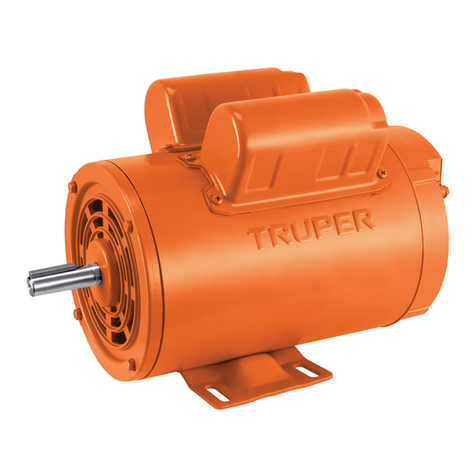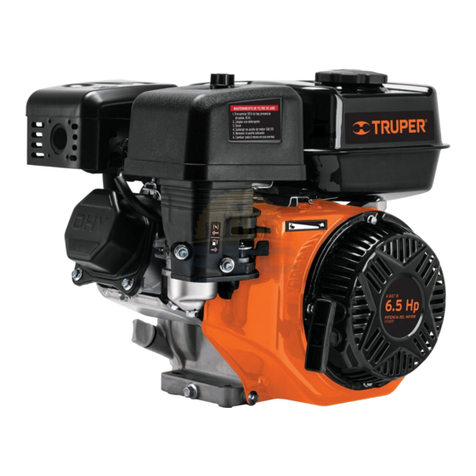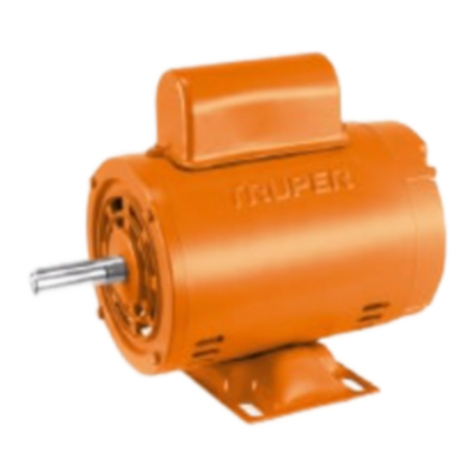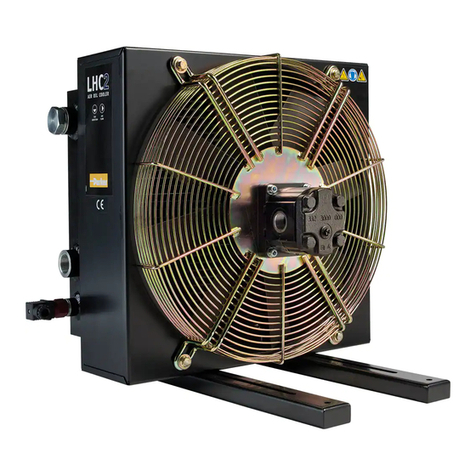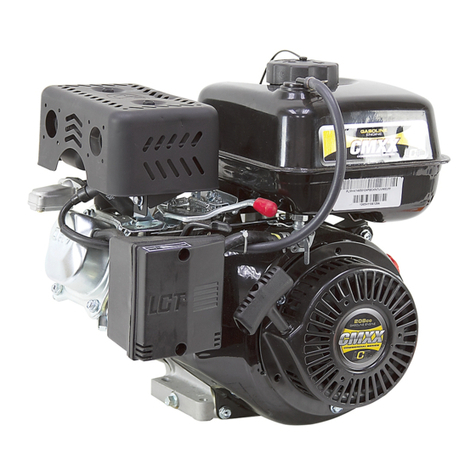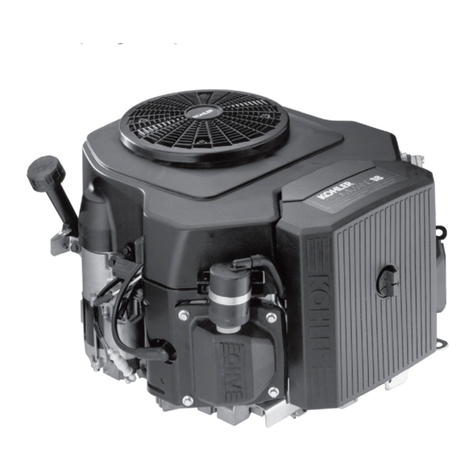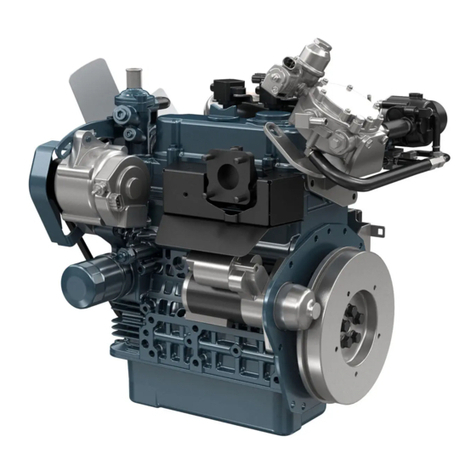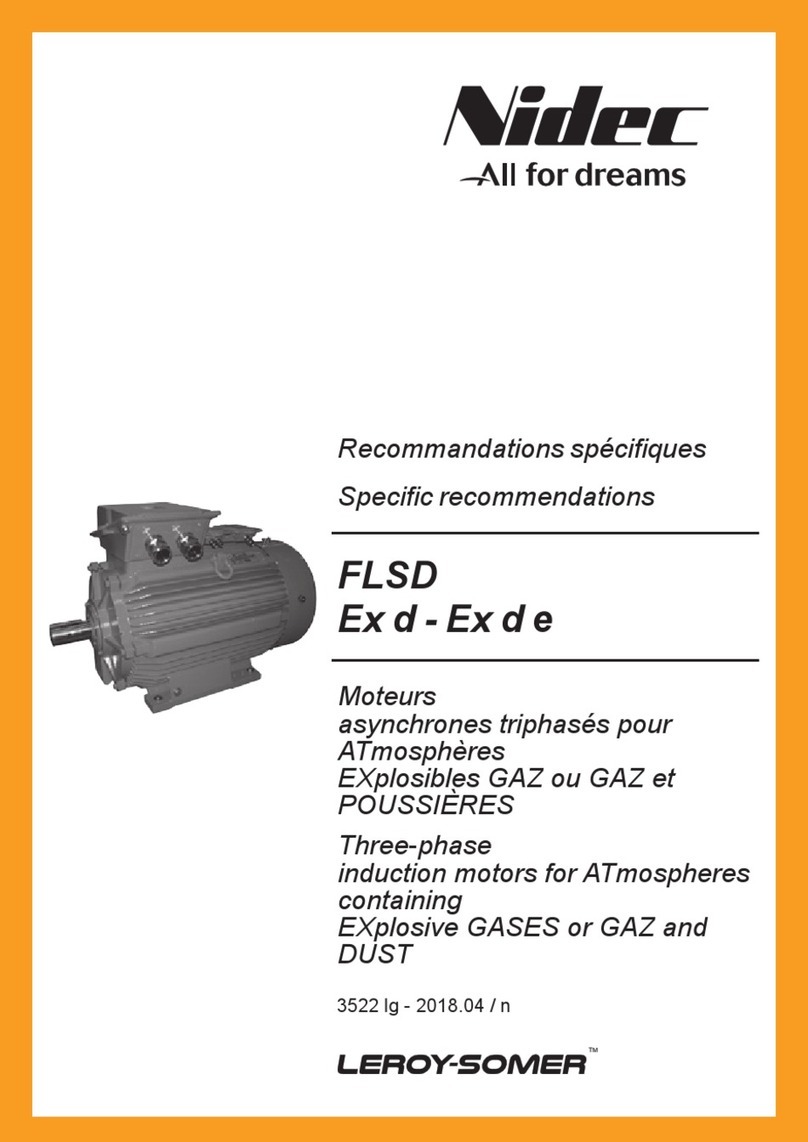Truper MOE-2A User manual

ModelsCodes
MOE-2A
MOE-1-1/2A
Applies for:
102313
102312
HIGH SPEED
3450 RPM
Manual
CAUTION
ENGLISH
ESPAÑOL
Read this manual thoroughly
before using the tool.
2-capacitor
Single-phase
Motor

2
MOE-2A
MOE-1-1/2A
Contents
ENGLISH
CAUTION
Keep this manual for future references.
The illustrations in this manual are for reference
only. They might be different from the real tool.
To gain the best performance of
the tool, prolong the duty life,
make the Warranty valid if
necessary, and to avoid hazards
of fatal injuries please read and
understand this Manual before
using the tool.
Technical Data
Dimensions
Electric requirements
General safety warnings for power tools
Safety warnings for electric motors
Parts
Mounting
Connections
Troubleshooting
Notes
Authorized Service Centers
Warranty Policy
3
3
4
5
6
6
7
8
9
12
13
14

2 Hp (1.491 kW) 1-1/2 Hp (1.118 kW)
MOE-2A MOE-1-1/2A
102312102313
High speed single phase electric motor with 2 capacitors
Code
Description
Rated power
15.6 A / 7.8 A19.4 A / 9.7 A
Current
14 kg 12 kg
Weight
17.4 A / 8.7 A22 A / 11 A
Current operating
at service factor
Permanently connected start-up and operating switches
Start type
29 cm30 cmLength (A)
Dimensions
A
7.6 cm
8.9 cm
21.5 cm
7 cm16.5 cm
12.4 cm
4.8 cm
3
Technical Data
56 (NEMA)
IP 21
104 °F
Class F
60 Hz
Frequency
Speed
1.15
Service factor
Maximum temperature
Insulation class
IP Grade
Frame
3450 RPM
Voltage 115 V / 230 V
Shaft diameter
1 3/8” x 3/16” (3.5 cm x 0.5 cm)
Shaft wedge
5/8” (1.6 cm)
Open drip-proof
Type of enclosure
ENGLISH

4ENGLISH
From 0 A up to 10 A
From 10 A up to 13 A
From 13 A up to 15 A
From 15 A up to 20 A
18 AWG (**)
16 AWG
14 AWG
8 AWG
16 AWG
14 AWG
12 AWG
6 AWG
3
(one grounded)
from 5.9’ to 49.2’ | higher than 49.2’
Ampere
capacity Number of
conductors (*)
Extension gauge
From 0 A up to 11 A
From 11 A up to 15 A
From 15 A up to 17 A
From 17 A up to 23 A
18 AWG (**)
16 AWG
14 AWG
10 AWG
16 AWG
14 AWG
12 AWG
8 AWG
3
(one grounded)
from 5.9’ to 49.2’ | higher than 49.2’
Ampere
capacity Number of
conductors (*)
Extension gauge
The equipment must be grounded to
prevent electric shock.
• Connect the plug into a properly grounded outlet. Not all
outlets are properly grounded, if you are not sure, check
with a qualified electrician.
• If the outlet available for the equipment is a 2-pole
(2-hole) outlet, DO NOT REMOVE OR ALTER THE
GROUND CONDUCTOR OF YOUR PLUG FOR ANY
REASON.
• Connection to the power source must
be made by an electrical professional, following one of the
diagrams on page 8.
• Use a separate electrical circuit for the
motor. This circuit must not have conductors with a gauge
smaller than 12 AWG, and must be protected with a 20 to
30 A time delay fuse depending on the current of each
model.
• Before connecting the motor to the power line, make
sure that the voltage is equal to that indicated on the
motor nameplate. Operating with a lower voltage will
damage the motor.
• The ground wire gauge must not be
smaller than the power supply wire gauge.
• It is recommended that the motor be supplied with a
circuit that includes a residual current circuit breaker with
a rated current of no more than 30 mA.
• The 0.560 kW motor has a built-in thermal protector to
protect against overheating. Motors from 0.746 kW to
1.491 kW do not have a thermal protector, it is
recommended to protect them by installing a motor
guard.
When using an
extension cord, make sure the
gauge is sufficient for the current
the equipment will draw.
Under-gauging will result in line
voltage drops, loss of power and
motor overheating. The following
tables show the correct gauges to
use depending on the length of the
cable and the ampere rating
indicated on the tool's nameplate.
If in doubt use the next higher
gauge.
All wiring, electrical connections and grounding of the system must comply with MEXICAN
OFFICIAL NOM-001-SEDE, ELECTRICAL INSTALLATIONS (UTILIZATION) or local codes and ordinances.
A qualified electrician must be employed.
230 Volts
115 Volts
* One of the conductors must be a grounding conductor. All conductors are of the same designation (gauge) including the grounding conductor.
** It is allowed to use it as long as the extensions themselves are provided with an overcurrent protection device.
AWG = American Wire Gauge. Reference: NMX-J-195-ANCE
Electric requirements
CAUTION
CAUTION
CAUTION
CAUTION
WARNING
WARNING

5
ENGLISH
General power tool
safety warnings
Work area
Keep your work area clean, and well lit.
Cluttered and dark areas may cause accidents.
Never use the tool in explosive atmospheres, such as in the
presence of flammable liquids, gases or dust.
Sparks generated by power tools may ignite the flammable material.
Keep children and bystanders at a safe distance while operating
the tool.
Distractions may cause loosing control.
Electrical Safety
The tool plug must match the power outlet. Never modify
the plug in any way. Do not use any adapter plugs with
grounded power tools.
Modified plugs and different power outlets increase the risk of electric shock.
Avoid body contact with grounded surfaces, such as pipes,
radiators, electric ranges and refrigerators.
The risk of electric shock increases if your body is grounded.
Do not expose the tool to rain or wet conditions.
Water entering into the tool increases the risk of electric shock.
Do not force the cord. Never use the cord to carry, lift or unplug
the tool. Keep the cord away from heat, oil, sharp edges or
moving parts.
Damaged or entangled cords increase the risk of electric shock.
When operating a tool outdoors, use an extension cord suitable
for outdoor use.
Using an adequate outdoor extension cord reduces the risk of electric shock.
If operating the tool in a damp location cannot be avoided, use
a ground fault circuit interrupter (GFCI) protected supply.
Using a GFCI reduces the risk of electric shock.
Personal safety
Stay alert, watch what you are doing and use common sense
when operating a tool. Do not use a power tool while you are
tired or under the influence of drugs, alcohol or medication.
A moment of distraction while operating the tool may result in personal injury.
Use personal protective equipment. Always wear eye
protection.
Protective equipment such as safety glasses, anti-dust mask, non-skid shoes,
hard hats and hearing protection used in the right conditions significantly
reduce personal injury.
Prevent unintentional starting up. Ensure the switch is in the
“OFF” position before connecting into the power source and /
or battery as well as when carrying the tool.
Transporting power tools with the finger on the switch or connecting power
tools with the switch in the “ON” position may cause accidents.
Remove any wrench or vice before turning the power tool on.
Wrenches or vices left attached to rotating parts of the tool may result in personal
injury.
Do not overreach. Keep proper footing and balance at all times.
This enables a better control on the tool during unexpected situations.
Dress properly. Do not wear loose clothing or jewelry. Keep
hair, clothes and gloves away from the moving parts.
Loose clothes or long hair may get caught in moving parts.
If you have dust extraction and recollection devices connected
onto the tool, inspect their connections and use them correctly.
Using these devices reduce dust-related risks.
Power Tools Use and Care
Do not force the tool. Use the adequate tool for your
application.
The correct tool delivers a better and safer job at the rate for which it was designed.
Do not use the tool if the switch is not working properly.
Any power tool that cannot be turned ON or OFF is dangerous and should be
repaired before operating.
Disconnect the tool from the power source and / or battery
before making any adjustments, changing accessories or
storing.
These measures reduce the risk of accidentally starting the tool.
Store tools out of the reach of children. Do not allow persons
that are not familiar with the tool or its instructions to
operate the tool.
Power tools are dangerous in the hands of untrained users.
Service the tool. Check the mobile parts are not misaligned or
stuck. There should not be broken parts or other conditions that
may affect its operation. Repair any damage before using the
tool.
Most accidents are caused due to poor maintenance to the tools.
Keep the cutting accessories sharp and clean.
Cutting accessories in good working conditions are less likely to bind and are
easier to control.
Use the tool, components and accessories in accordance with
these instructions and the projected way to use it for the type of
tool when in adequate working conditions.
Using the tool for applications different from those it was designed for, could
result in a hazardous situation.
Service
Repair the tool in a Authorized Service Center
using only identical spare parts.
This will ensure that the safety of the power tool is maintained.
Children or people with reduced physical; sensory or mental
capabilities shall not operate the tool, neither inexperienced
people or without knowledge in the use of the tool, unless
supervised by a person responsible of their safety or if receiving
previous instructions about the tool operation.
Children shall be kept under supervision to double-check they will not play
with the tool. Tight supervision shall be used with children or disabled
persons to prevent from using or being close to any household tool.
WARNING! Read carefully all safety warnings and instruction listed below. Failure to comply with any of
these warnings may result in electric shock, fire and / or severe damage. Save all warnings and instructions for
future references.
This tool is in compliance with
the Official Mexican Standard
(NOM - Norma Oficial Mexicana).

6
Ventilation
slots Ventilation
slots
Shaft
Starting and
working
capacitors
Shaft
key Connection
panel cover
Cable outlet
to ground
Base with
fixing holes
Power cord
inlet
Name
plate
ENGLISH
Safety warnings
for electric motors
Parts
• Before installing or operating the
equipment, disconnect from any power source to avoid
electric shock and/or burns due to short circuits.
• Do not touch the bare (unprotected)
terminal. An electric shock will result.
• Do not touch any live lines simultaneously,
an electric shock will result.
• Do not install or handle equipment without
proper protective equipment or with wet hands.
• Do not install, connect, disconnect or handle the equipment
under load. With the exception of socket outlets, never
connect pluggable equipment when it is energized.
• If you do not have or doubt that you have the appropriate
technical knowledge, never install or handle the equipment.
• Before installation, be sure to read these operating
instructions carefully to ensure correct operation.
• Installation, maintenance and inspection of
electrical equipment must be carried out by qualified
technicians with special knowledge.
• Do not install the equipment in an environment with shock,
high temperature, humidity, dust, corrosive gases, excessive
vibration, etc. to avoid fire accidents and/or equipment
malfunction.
• Use electrical equipment with the voltage and current ratings
shown on the nameplate, otherwise it may cause
malfunctions and even dangerous situations.
• Tighten the terminal screws to the proper torque to prevent
overheating.
• Make sure that the equipment and the connection cables
are securely fastened.
• Always use terminals on the cables to which the equipment
is connected, these must be suitable for the load to be
supported.
• If there are several terminals in close proximity, each
terminal or conductor pole must be connected in parallel.
• If the equipment is equipped with grounding terminals,
make sure they are grounded.
• Always connect the equipment according to the indications
and diagrams provided by the manufacturer.
• Never exceed the operating ranges indicated by the
manufacturer.
• Do not modify the equipment.
• When the equipment is to be disposed of, it should be
disposed of as industrial waste.
• Do not connect aluminum terminals and conductors to the
switch directly.
• Always comply with the regulations in force at the place of
installation.
CAUTION
CAUTION
CAUTION
CAUTION
CAUTION

A
1 2
3
B
7
ENGLISH
Mounting
• Before mounting the motor remove
the plastic cover from the shaft and rotate it by hand.
The motor shaft must rotate freely.
• The motor is mounted by means of its rigid base,
which must be fixed on a flat surface prepared for
installation according to the dimension table shown on
page 3, using four 5/16” (8 mm) diameter screws or
threaded bolts.
• If mounting on steel plate (A) it is recommended that
the thickness of the steel plate be no less than the bolt
diameter.
• For mounting on concrete or concrete slab (B), a free
bolt thread length of not less than 7/16” (11 mm) is
recommended.
• Use a drop level or laser to validate motor levelness.
If the motor is not level, use calibrated adjustment
blades to shim the motor base and correct any
deviations in flatness between surfaces.
Motor mounting
• The motor shaft includes a 3/16” (0.5 cm) x 1-3/8”
(3.5 cm) key to transmit motion to the coupling.
• Depending on the application, the shaft can be coupled
to the machine in three ways:
1. Gear or sprocket coupling.
2. Coupling by pulleys or flywheel.
3. Coupling by connecting joint.
• In any of the cases, a correct alignment of the couplings
must be ensured to reduce the vibration of the assembly
between the motor and the driven machine and to
extend the life of the bearings and avoid damage to the
motor shaft.
• The use of flexible couplings, capable of absorbing
small alignment deviations inherent to the installation
during operation of the equipment, is recommended.
• In applications of coupling by means of connecting
joints, the motor must be aligned both axially and radially
as shown in the image.
Shaft joint
CAUTION

Ground Ground
Red
Blue
Orange
Black
White
Yellow
Line 1
Line 2
230 Volts115 Volts
1
2
3
4
Red
Blue
Orange
Black
White
Yellow
Line 1
Line 2
1
2
3
4
8
Connections
Voltage configuration
Direction of rotation configuration
A
• When using any of the configurations shown above,
the motor shaft rotates clockwise as viewed from the
connection panel. To reverse counterclockwise rotation:
interchange the red and black wires.
• To perform the wiring, make sure
that the lines are not energized.
• Remove the rear cover (A) to access the connection
panel.
• Make the connections according to the voltage
configuration that best suits your needs.
ENGLISH
Mounting
• For belt and chain drive applications, verify that the
centers of the drive and driven pulleys and/or sprockets
are aligned with each other as shown.
• Proper alignment and mounting will reduce motor
noise and workload vibration.
CAUTION

9
Troubleshooting
ENGLISH
The engine takes a
long time to
accelerate.
Motor does not start
after initial
installation.
The shaft rotates in
the opposite
direction.
The overload
protector trips
continuously.
Engine has been
running and then will
not start.
• Defective bearings.
• Defective capacitor.
• Faulty stationary switch.
• Voltage too low.
• The fan guard is bent and in contact with
the fan.
• The motor is damaged and the rotor is
hitting the stator.
• The motor has bad wiring.
• Wiring configured to rotate in the
opposite direction.
• Ambient temperature too high.
• The winding is shorted or grounded.
• Protector may be defective.
• Excessive load.
• The motor or its capacitor may have
failed.
• The stator is shorted or has gone to
ground. The motor will hum and the circuit
breaker or fuse will trip.
• The starter switch has failed.
• The fuse or circuit breaker has tripped.
• Motor overloaded or load stuck.
• The bearing must be replaced.
• Refer to a Authorized Service
Center for repair.
• Inspect and repair the switch contacts and connections.
• Make sure the voltage is within 10% of the motor
rating. If not, contact the power company or check to see
if other equipment is drawing power away from the
motor.
• Refer to a Authorized Service
Center for repair.
• Check that the motor is correctly wired according to the
information supplied with the motor.
• Rewire the motor according to the configuration
diagram on page 8.
• Check that the motor receives sufficient air for proper
cooling. The motor is designed to operate below 104 °F
Note: A properly running motor may be hot to the touch.
• Inspect the stator for defects or loose or cut wires that
may cause it to ground.
• Refer to a Authorized Service
Center for repair.
• Verify that the load is not jammed. If the motor is a
a replacement, verify that the rating is the same as the
old motor. If the old motor was a special design, a stock
motor may not be able to match the performance.
Remove the load from the motor and inspect the
amperage draw of the motor under load. It should be
less than the full load rating stamped on the nameplate.
• First discharge the capacitor. To check the capacitor, set
the voltmeter to the RX100 scale and touch its probes to
the capacitor terminals. If the capacitor is OK, the needle
will jump to zero ohms and back up again. A steady zero
ohms indicates a short circuit; a steady high ohm
indicates an open circuit.
• Disassemble the motor and inspect the winding and
internal connections. A burned stator will show a burn
mark. The motor must be replaced or the stator
rewound.
• Disassemble the motor and inspect the centrifugal and
stationary switches. The centrifugal switch weights should
move freely in and out. Make sure the switch is not loose
on the shaft. Inspect the contacts and connections of the
stationary switch. Replace the switch if the contacts are
burned or pitted
• Replace the fuse or reset the circuit breaker.
• Inspect to see that the load is free. Check motor amp
draw against nameplate rating.
Problem Cause Solution

Troubleshooting
10 ENGLISH
Motor runs, but shuts
off.
The motor vibrates.
Run capacitor failure.
Starting capacitors
are constantly failing.
A loud rubbing or
squeaking noise is
produced at start-up.
• Voltage drops.
• Load increase.
• Unbalanced load.
• Unbalanced rotor.
• Defective motor bearings.
• Motor misaligned with load.
• Too much backlash at motor ends.
• Defective windings.
• Possible power surge in the motor caused
by lightning or other high transient voltage.
• Ambient temperature is too high.
• The motor starts too often.
• Motor is not coming up to speed fast
enough.
• The starter switch may be defective,
preventing the motor from coming out of
the starter winding.
• Motor voltage is too low.
• The rotor may be hitting the stator.
• If the voltage is less than 10% of the motor rating,
contact the power company.
• Check to see if any other equipment is drawing
power from the motor and if the motor is running on
an extension cord. Verify that the extension cord is the
proper gauge for the motor current.
• Remove the load from the motor for inspection.
Verify that the shaft is not bent. Rule of thumb:
0.001”deflection per inch of shaft length.
• Remove the load from the motor to inspect it. If it
feels rough and vibrates but the bearings are OK, the
rotor may have been improperly balanced at the
factory. Refer to a Authorized
Service Center for repair.
• If the bearings are bad, you will hear a noise or feel a
roughness. Go to a Authorized
Service Center to replace the bearings. Add grease if
the bearings have fittings.
• Realign the load.
• With the motor disconnected from power, rotate the
shaft. It should move, but with some resistance. If the
shaft moves in and out freely, this indicates a preload
problem and the bearings may need additional shims.
• Check to see if the winding is shorted or open. Amps
may also be high. Refer to a Au-
thorized Service Center for repair.
• This is a common problem. Install an over voltage
protector or motor protector relay.
• Verify that the ambient temperature does not exceed
the motor nameplate.
• Check the duty cycle. Capacitor manufacturers
recommend no more than 20 starts of three-second
per hour. Install a capacitor with a higher voltage rating
or add a bleeder resistor to the capacitor.
• The motor may not be properly sized. Check the time
it takes for the motor to reach speed. Most
single-phase motors with starting capacitors should
reach speed in three seconds. If not, the capacitors
may be failing.
• Replace the switch.
• Verify that the motor voltage is within 10% of the
nameplate value.
• Make sure that the motor has not been damaged
during transport.
• Damage to the frame may not be repairable. If you
cannot see physical damage, inspect the motor rotor
and stator for scuff marks. If there are signs of scuffing,
the motor should be replaced. Sometimes, simply
disassembling and reassembling the motor will
eliminate the scuffing.
Sometimes end bells become misaligned during
shipping.
Problem Cause Solution

11
Troubleshooting
ENGLISH
Bearings fail
continuously.
Elevated or
abnormal noise.
• High ambient temperature.
• Motor load may be excessive or
unbalanced.
• Defect of the components of the driven
machine.
• Misaligned base or unlevel motor.
• Incorrect motor rotation direction.
• Loose fixing screws.
• Deteriorated bearings.
• If the engine is operated in a warm environment, a
different type of bearing grease may be required. Contact
a Authorized Service Center
for a recommendation of the proper type of grease.
• In addition to checking the load, also inspect the drive
belt tension to make sure it is not tight or perhaps too
high. An unbalanced tip will also cause the bearings to
fail.
• Check the power transmission of the applied load.
• Align and level the motor and load.
• Reverse the direction of rotation of the load.
• Tighten the fixing bolts.
• Replace bearings.
Problem Cause Solution
If problems persist despite performing the recommended corrective actions,
contact a Authorized Service Center.

12
Notes
ENGLISH

13
ENGLISH
Authorized Service Centers
In the event of any problem contacting a Truper Authorized Service Center, please see our webpage www.truper.com
to get an updated list, or call our toll-free numbers 800 690-6990 or 800 018-7873 to get information about the
nearest Service Center.
AGUASCALIENTES
BAJA
CALIFORNIA
BAJA
CALIFORNIA SUR
CAMPECHE
CHIAPAS
CHIHUAHUA
CIUDAD DE
MÉXICO
COAHUILA
COLIMA
DURANGO
ESTADO DE
MÉXICO
GUANAJUATO
GUERRERO
HIDALGO
JALISCO
MICHOACÁN
MORELOS
NAYARIT
NUEVO LEÓN
OAXACA
PUEBLA
QUERÉTARO
QUINTANA ROO
SAN LUIS
POTOSÍ
SINALOA
SONORA
TABASCO
TAMAULIPAS
TLAXCALA
VERACRUZ
YUCATÁN
DE TODO PARA LA CONSTRUCCIÓN
GRAL. BARRAGÁN #1201, COL. GREMIAL, C.P. 20030,
AGUASCALIENTES, AGS. TEL.: 449 994 0537
SUCURSAL TIJUANA
AV. LA ENCANTADA, LOTE #5, PARQUE INDUSTRIAL EL
FLORIDO II, C.P 22244, TIJUANA, B.C.
TEL.: 664 969 5100
FIX FERRETERÍAS
FELIPE ÁNGELES ESQ. RUIZ CORTÍNEZ S/N, COL. PUEBLO
NUEVO, C.P. 23670, CD. CONSTITUCIÓN, B.C.S.
TEL.: 613 132 1115
TORNILLERÍA Y FERRETERÍA AAA
AV. ÁLVARO OBREGÓN #324, COL. ESPERANZA
C.P. 24080 CAMPECHE, CAMP. TEL.: 981 815 2808
FIX FERRETERÍAS
AV. CENTRAL SUR #27, COL. CENTRO, C.P. 30700,
TAPACHULA, CHIS. TEL.: 962 118 4083
SUCURSAL CHIHUAHUA
AV. SILVESTRE TERRAZAS #128-11, PARQUE INDUSTRIAL
BAFAR, CARRETERA MÉXICO CUAUHTÉMOC, C.P. 31415,
CHIHUAHUA, CHIH. TEL. 614 434 0052
FIX FERRETERÍAS
EL MONSTRUO DE CORREGIDORA, CORREGIDORA # 22,
COL. CENTRO, C.P. 06060, CUAUHTÉMOC, CDMX.
TEL: 55 5522 5031 / 5522 4861
SUCURSAL TORREÓN
CALLE METAL MECÁNICA #280, PARQUE INDUSTRIAL
ORIENTE, C.P. 27278, TORREÓN, COAH.
TEL.: 871 209 68 23
BOMBAS Y MOTORES BYMTESA DE MANZANILLO
BLVD. MIGUEL DE LA MADRID #190, COL. 16 DE
SEPTIEMBRE, C.P. 28239, MANZANILLO, COL.
TEL.: 314 332 1986 / 332 8013
TORNILLOS ÁGUILA, S.A. DE C.V.
MAZURIO #200, COL. LUIS ECHEVERRÍA, DURANGO,
DGO.TEL.: 618 817 1946 / 618 818 2844
SUCURSAL CENTRO JILOTEPEC
PARQUE INDUSTRIAL # 1, COL. PARQUE INDUSTRIAL
JILOTEPEC, JILOTEPEC, EDO. DE MÉX. C.P. 54257
TEL: 761 782 9101 EXT. 5728 Y 5102
CÍA. FERRETERA NUEVO MUNDO S.A. DE C.V.
AV. MÉXICO - JAPÓN #225, CD. INDUSTRIAL, C.P. 38010,
CELAYA, GTO. TEL.: 461 617 7578 / 79 / 80 / 88
CENTRO DE SERVICIO ECLIPSE
CALLE PRINCIPAL MZ.1 LT. 1, COL. SANTA FE, C.P. 39010,
CHILPANCINGO, GRO. TEL.: 747 478 5793
FERREPRECIOS S.A. DE C.V.
LIBERTAD ORIENTE #304 LOCAL 30, INTERIOR DE PASAJE
ROBLEDO, COL. CENTRO, C.P. 43600, TULANCINGO,
HGO. TEL.: 775 753 6615 / 775 753 6616
SUCURSAL GUADALAJARA
AV. ADOLFO B. HORN # 6800, COL: SANTA CRUZ DEL
VALLE, C.P.: 45655, TLAJOMULCO DE ZUÑIGA, JAL.
TEL.: 33 3606 5285 AL 90
FIX FERRETERÍAS
AV. PASEO DE LA REPÚBLICA #3140-A, COL.
EX-HACIENDA DE LA HUERTA, C.P. 58050, MORELIA,
MICH. TEL.: 443 334 6858
FIX FERRETERÍAS
CAPITÁN ANZURES #95, ESQ. JOSÉ PERDIZ, COL.
CENTRO, C.P. 62740, CUAUTLA, MOR.
TEL.: 735 352 8931
HERRAMIENTAS DE TEPIC
MAZATLAN #117, COL. CENTRO, C.P. 63000, TEPIC, NAY.
TEL.: 311 258 0540
SUCURSAL MONTERREY
CARRETERA LAREDO #300, 1B MONTERREY PARKS,
COLONIA PUERTA DE ANÁHUAC, C.P. 66052, ESCOBEDO,
NUEVO LEÓN, TEL.: 81 8352 8791 / 81 8352 8790
FIX FERRETERÍAS
AV. 20 DE NOVIEMBRE #910, COL. CENTRO, C.P. 68300,
TUXTEPEC, OAX. TEL.: 287 106 3092
SUCURSAL PUEBLA
AV PERIFÉRICO #2-A, SAN LORENZO ALMECATLA,
C.P. 72710, CUAUTLACINGO, PUE.
TEL.: 222 282 8282 / 84 / 85 / 86
ARU HERRAMIENTAS S.A DE C.V.
AV. PUERTO DE VERACRUZ #110, COL. RANCHO DE
ENMEDIO, C.P. 76842, SAN JUAN DEL RÍO, QRO.
TEL.: 427 268 4544
FIX FERRETERÍAS
CARRETERA FEDERAL MZ. 46 LT. 3 LOCAL 2, COL EJIDAL,
C.P. 77710 PLAYA DEL CARMEN, Q.R.
TEL.: 984 267 3140
FIX FERRETERÍAS
AV. UNIVERSIDAD #1850, COL. EL PASEO, C.P. 78320,
SAN LUIS POTOSÍ, S.L.P. TEL.: 444 822 4341
SUCURSAL CULIACÁN
AV. JESÚS KUMATE SUR #4301, COL. HACIENDA DE LA
MORA, C.P. 80143, CULIACÁN, SIN.
TEL.: 667 173 9139 / 173 8400
FIX FERRETERÍAS
CALLE 5 DE FEBRERO #517, SUR LT. 25 MZ. 10, COL.
CENTRO, C.P. 85000, CD. OBREGÓN, SON.
TEL.: 644 413 2392
SUCURSAL VILLAHERMOSA
CALLE HELIO LOTES 1, 2 Y 3 MZ. #1, COL. INDUSTRIAL,
2A ETAPA, C.P. 86010, VILLAHERMOSA, TAB.
TEL.: 993 353 7244
VM ORINGS Y REFACCIONES
CALLE ROSITA #527 ENTRE 20 DE NOVIEMBRE Y GRAL.
RODRÍGUEZ, FRACC. REYNOSA, C.P. 88780, REYNOSA,
TAMS. TEL.: 899 926 7552
SERVICIOS Y HERRAMIENTAS INDUSTRIALES
PABLO SIDAR #132, COL . BARRIO DE SAN BARTOLOMÉ,
C.P. 90970, SAN PABLO DEL MONTE, TLAX.
TEL.: 222 271 7502
LA CASA DISTRIBUIDORA TRUPER
BLVD. PRIMAVERA. ESQ. HORTENSIA S/N, COL.
PRIMAVERA C.P. 93308, POZA RICA, VER.
TEL.: 782 823 8100 / 826 8484
SUCURSAL MÉRIDA
CALLE 33 #600 Y 602, LOCALIDAD ITZINCAB Y MULSAY,
MPIO. UMÁN, C.P. 97390, MÉRIDA, YUC.
TEL.: 999 912 2451

14 www.truper.com
06-2022
MOE-2A
MOE-1-1/2A
102313
102312
ENGLISH
1
YEAR
Warranty
policy
Stamp of the business. Delivery date:
CodeModel Brand
Warranty. Duration: 1 year. Coverage: parts, components and workmanship against manufacturing or operating
defects, except if used under conditions other than normal; when it was not operated in accordance with the
instructive; was altered or repaired by personnel not authorized by Truper®. To make the warranty valid, present
the product, stamped policy or invoice or receipt or voucher, in the establishment where you bought it or in
Corregidora 22, Centro, Cuauhtémoc, CDMX, 06060, where you can also purchase parts, components,
consumables and accessories. It includes the costs of transportation of the product that derive from its fulfillment
of its service network. . Phone number 800-018-7873. Made in China. Imported by Truper, S.A. de C.V. Parque
Industrial 1, Parque Industrial Jilotepec, Jilotepec, Edo. de Méx. C.P. 54257, Phone number 761 782 9100.

Instructivo de
Motores
monofásicos
de dos capacitores
ModelosCódigos
MOE-2A
MOE-1-1/2A
Este instructivo es para:
102313
102312
ALTA VELOCIDAD
3450 r/min
ESPAÑOL
ENGLISH
ATENCIÓN Lea este Instructivo por completo
antes de usar la herramienta.

Í
ndice
2
Especificaciones técnicas
Dimensiones
Requerimientos eléctricos
Advertencias Generales de Seguridad
para herramientas eléctricas
Advertencias de Seguridad
para uso de motores eléctricos
Partes
Montaje
Conexiones
Solución de problemas
Notas
Centros de Servicio Autorizados
Póliza de Garantía
Guarde este instructivo para futuras referencias.
Los gráficos de este instructivo son para
referencia, pueden variar del aspecto real de la
herramienta.
3
3
4
5
6
MOE-2A
MOE-1-1/2A
Para poder sacar el máximo
provecho de la herramienta,
alargar su vida útil, hacer válida
la garantía en caso de ser
necesario y evitar riesgos o
lesiones graves, es fundamental
leer este instructivo por
completo antes de usar la
herramienta.
ATENCIÓN
ESPAÑOL
6
7
8
9
12
13
14

2 Hp (1.491 kW) 1-1/2 Hp (1.118 kW)
MOE-2A MOE-1-1/2A
102312102313
Motor eléctrico monofásico de alta velocidad con 2 capacitores
Código
Descripción
Potencia nominal
15.6 A / 7.8 A19.4 A / 9.7 A
Corriente
14 kg 12 kg
Peso
17.4 A / 8.7 A22 A / 11 A
Corriente operando
al factor de servicio
Dos capacitores, de arranque y de trabajo permanentemente conectadoTipo de arranque
29 cm30 cmLongitud (A)
Dimensiones
A
7.6 cm
8.9 cm
21.5 cm
7 cm16.5 cm
12.4 cm
4.8 cm
3
Especificaciones técnicas
ESPAÑOL
56 (NEMA)
IP 21
40 °C
Clase F
60 Hz
Frecuencia
Velocidad
1.15
Factor de servicio
Temperatura máxima
Clase de aislamiento
Grado IP
Armazón
3450 r/min
Voltaje 115 V / 230 V
Diámetro del eje
1 3/8” x 3/16” (3.5 cm x 0.5 cm)
Cuña del eje
5/8” (1.6 cm)
Abierto a prueba de goteo
Tipo de enclaustramiento

4ESPAÑOL
de 0 A hasta 10 A
de 10 A hasta 13 A
de 13 A hasta 15 A
de 15 A hasta 20 A
18 AWG (**)
16 AWG
14 AWG
8 AWG
16 AWG
14 AWG
12 AWG
6 AWG
3
(uno a tierra)
de 1.8 m a 15 m | mayor de 15 m
Capacidad en
Amperes Número de
conductores (*)
Calibre de extensión
de 0 A hasta 11 A
de 11 A hasta 15 A
de 15 A hasta 17 A
de 17 A hasta 23 A
18 AWG (**)
16 AWG
14 AWG
10 AWG
16 AWG
14 AWG
12 AWG
8 AWG
3
(uno a tierra)
de 1.8 m a 15 m | mayor de 15 m
Capacidad en
Amperes Número de
conductores (*)
Calibre de extensión
El equipo debe ser conectado a
tierra para evitar una descarga eléctrica.
• Conecte la clavija en un tomacorriente debidamente
aterrizado. No todos los tomacorrientes están propiamente
aterrizados, si no está seguro verifique con un eléctrico
calificado.
• Si el tomacorriente disponible para el equipo es de 2
polos (2 orificios), NO REMUEVA O ALTERE EL
CONDUCTOR DE TIERRA DE SU CLAVIJA POR NINGÚN
MOTIVO.
• La conexión a la fuente de energía
debe realizarse por un profesional en electricidad,
siguiendo alguno de los diagramas de la página 8.
• Use un circuito eléctrico separado
para el motor. Este circuito no debe tener conductores
con un calibre inferior a 12 AWG, y debe estar protegido
con un fusible con demora de tiempo de 20 A a 30 A
dependiendo de la corriente de cada modelo.
• Antes de conectar el motor a la línea de corriente,
asegúrese de que la tensión sea igual a la indicada en la
placa de datos del motor. Si se opera con una tensión
menor, se dañará el motor.
• El calibre del cable de conducción a
tierra no puede ser de menor calibre que el cable de
suministro eléctrico.
• Es recomendableque el motor se alimente con un
circuito que incluya un interruptor diferencial con una
corriente asignada no mayor a 30 mA
• Todos los motores hasta 0.560 kW cuentan con un
protector térmico incorporado para protegerlos ante un
sobre calentamiento. Los motores de 0.746 kW a 1.491
kW no cuentan con protector térmico, recomendamos
protegerlo mediante la instalación de un guardamotores.
Al usar un cable
de extensión, asegúrese que el
calibre sea suficiente para la
corriente que consumirá el equipo.
Un calibre inferior ocasionará
caídas de tensión en la línea,
pérdida de potencia y sobrecalen-
tamiento del motor. Las tablas
siguientes muestran los calibres
correctos que debe usarse
dependiendo de la longitud del
cable y de la capacidad de amperes
indicada en la placa de datos de la
herramienta. Si tiene dudas use el
siguiente calibre más alto.
Todo el cableado, las conexiones eléctricas y la conexión a tierra del sistema deben cumplir
con la NORMA OFICIAL MEXICANA NOM-001-SEDE, INSTALACIONES ELÉCTRICAS (UTILIZACIÓN) o con los
códigos y ordenanzas locales. Debe emplear un electricista calificado.
ADVERTENCIA
ADVERTENCIA
ATENCIÓN 230 Volts
115 Volts
* Uno de los conductores debe ser conductor para puesta a tierra. Todos los conductores son de la misma designación (calibre) incluyendo el de puesta a tierra.
** Se permite utilizarlo siempre y cuando las extensiones mismas cuenten con un artefacto de protección contra sobrecorriente.
AWG = Calibre de alambre estadounidense (American Wire Gauge). Referencia: NMX-J-195-ANCE
Requerimientos eléctricos
ATENCIÓN
ATENCIÓN
ATENCIÓN

Esta herramienta cumple con la
Norma Oficial Mexicana (NOM).
Área de trabajo
Mantenga el área de trabajo limpia y bien iluminada.
Las áreas desordenadas y obscuras son propensas a accidentes.
No maneje la herramienta en ambientes explosivos, como en
presencia de líquido, gas o polvo inflamables.
Las herramientas eléctricas producen chispas que pueden encender
material inflamable.
Mantenga alejados a los niños y curiosos cuando opere la
herramienta.
Las distracciones pueden hacer que pierda el control.
Seguridad eléctrica
La clavija de la herramienta debe coincidir con el tomacorrien-
te. Nunca modifique una clavija. No use ningún tipo de
adaptador para clavijas de herramientas puestas a tierra.
Clavijas modificadas y enchufes diferentes aumentan el riesgo de
choque eléctrico.
Evite el contacto del cuerpo con superficies puestas a tierra
como tuberías, radiadores, cocinas eléctricas y refrigeradores.
Hay un mayor riesgo de choque eléctrico si el cuerpo está puesto a tierra.
No exponga la herramienta a la lluvia o condiciones de humedad.
El agua que ingresa en la herramienta aumenta el riesgo de choque eléctrico.
No fuerce el cable. Nunca use el cable para transportar,
levantar o desconectar la herramienta. Mantenga el cable
lejos del calor, aceite, orillas afiladas o piezas en movimiento.
Los cables dañados o enredados aumentan el riesgo de choque eléctrico.
Cuando maneje una herramienta en exteriores, use una
extensión especial para uso en exteriores.
El uso de una extensión adecuada para exteriores reduce el riesgo de choque
eléctrico.
Si el uso de la herramienta en un lugar húmedo es inevitable,
use una alimentación protegida por un interruptor de circuito
de falla a tierra (GFCI).
El uso de un GFCI reduce el riesgo de choque eléctrico.
Seguridad personal
Esté alerta, vigile lo que está haciendo y use el sentido común
cuando maneje una herramienta. No la use si está cansado o
bajo la influencia de drogas, alcohol o medicamentos.
Un momento de distracción mientras maneja la herramienta puede
causar un daño personal.
Use equipo de seguridad. Use siempre protección para los ojos.
El uso de equipo de seguridad como lentes de seguridad, mascarilla antipolvo,
zapatos antideslizantes, casco y protección para los oídos en condiciones
apropiadas, reduce de manera significativa los daños personales.
Evite arranques accidentales. Asegúrese de que el interruptor
está en posición “apagado” antes de conectar a la fuente de
alimentación y/o a la batería o transportar la herramienta.
Transportar herramientas eléctricas con el dedo sobre el interruptor o
conectar herramientas eléctricas que tienen el interruptor en posición de
“encendido” puede causar accidentes.
Retire cualquier llave o herramienta de ajuste antes de arrancar
la herramienta eléctrica.
Las llaves o herramientas que quedan en las partes rotativas de la
herramienta pueden causar un daño personal.
No sobrepase su campo de acción. Mantenga ambos pies bien
asentados sobre el suelo y conserve el equilibrio en todo
momento.
Esto permite un mejor control de la herramienta en situaciones inesperadas.
Vista adecuadamente. No vista ropa suelta o joyas. Mantenga su
pelo, su ropa y guantes alejados de las piezas en movimiento.
La ropa o el pelo suelto o las joyas pueden quedar atrapados en
las piezas en movimiento.
En caso de contar con dispositivos de extracción y recolección
de polvo conectados a la herramienta, verifique sus conexiones
y úselos correctamente.
El uso de estos dispositivos reduce los riesgos relacionados con el polvo.
Uso y cuidados de la herramienta
No fuerce la herramienta. Use la herramienta adecuada para el
trabajo a realizar.
La herramienta adecuada hace un trabajo mejor y más seguro cuando
se usa al ritmo para el que fue diseñado.
No use la herramienta si el interruptor no funciona.
Cualquier herramienta eléctrica que no pueda encenderse o
apagarse es peligrosa y debe repararse antes de ser operada.
Desconecte la herramienta de la fuente de alimentación y/o de
la batería antes de efectuar cualquier ajuste, cambiar accesorios
o almacenarla.
Estas medidas reducen el riesgo de arrancar la herramienta accidentalmente.
Almacene las herramientas fuera del alcance de los niños y no
permita su manejo por personas no familiarizadas con las
herramientas o con las instrucciones.
Las herramientas eléctricas son peligrosas en manos no entrenadas.
Déle mantenimiento a la herramienta. Compruebe que las
partes móviles no estén desalineadas o trabadas, que no
haya piezas rotas u otras condiciones que puedan afectar su
operación. Repare cualquier daño antes de usar la herramienta.
Muchos accidentes son causados por el escaso mantenimiento de las
herramientas.
Mantenga los accesorios de corte afilados y limpios.
Los accesorios de corte en buenas condiciones son menos probables de
trabarse y más fáciles de controlar.
Use la herramienta, sus componentes y accesorios de acuerdo
con estas instrucciones y de la manera prevista para el tipo de
herramienta, en condiciones de trabajo adecuadas.
El uso de la herramienta para aplicaciones diferentes para las que
está diseñada podría causar una situación de peligro.
Servicio
Repare la herramienta en un Centro de Servicio Autorizado
usando sólo piezas de repuesto idénticas.
Para mantener la seguridad de la herramienta.
La máquina no debe de ser utilizada por niños ni por personas
con capacidades físicas, sensoriales o mentales reducidas;
tampoco por personas sin experiencia o conocimientos en su
uso, a menos que estén supervisadas por una persona
responsable de su seguridad o reciban instrucciones previas
sobre el uso de la máquina.
Los niños deben de estar bajo supervisión para asegurarse de que no jueguen
con la máquina. Se debe de mantener una estricta supervisión si niños o
personas discapacitadas llegan a utilizar cualquier tipo de aparato
electrodoméstico o estén cerca de él.
¡ADVERTENCIA! Lea detenidamente todas las advertencias de seguridad y todas las instrucciones que se enlistan a continuación. La omisión de
alguna de ellas puede dar como resultado un choque eléctrico, incendio y/o daño serio. Conserve las advertencias y las instrucciones para futuras referencias.
Advertencias generales de seguridad
para herramientas eléctricas
5
ESPAÑOL

6ESPAÑOL
Entradas de aire
para ventilación Ranuras
de ventilación
Eje
Capacitores
de arranque
y de trabajo
Cuña
del eje Tapa de caja
de conexiones
Salida de
cable a tierra
Base con orificios
para fijación
Entrada de
cable de
alimentación
Partes
Advertencias Seguridad
para uso de motores eléctricos
• Antes de instalar o manipular desconecte
el equipo de cualquier fuente de energía para evitar descargas
eléctricas y/o quemaduras debido a cortocircuitos.
• No toque ningún terminal desnuda (sin
protección). Se producirá una descarga eléctrica.
• No toque dos líneas activas simultánea-
mente, se producirá una descarga eléctrica.
• No instale o manipule el equipo sin los
elementos de protección adecuados ni con las manos
húmedas.
• No instale, conecte o desconecte o manipule el equipo con
carga. A excepción de las tomas de corriente, en los equipos
enchufables, nunca los conecte estando en tensión.
• Si no dispone o duda de tener los conocimientos técnicos
adecuados no instale o manipule nunca el equipo.
• Antes de la instalación, asegúrese de leer atentamente estas
instrucciones de funcionamiento para garantizar un
funcionamiento correcto.
• La instalación, el mantenimiento y la
inspección de equipos eléctricos deben ser realizados por
técnicos cualificados con conocimientos especiales.
• No instale el equipo en lugar de un entorno con golpes, alta
temperatura, humedad, polvo, gases corrosivos, vibraciones
excesivas, etc. para evitar accidentes de incendio y/o mal
funcionamiento del equipo.
Placa de
especificaciones
• Utilice los equipos eléctricos con los rangos de voltaje y
corriente nominal que se muestra en la placa de especificacio-
nes técnicas, si no puede causar un mal funcionamiento e
incluso provocar situaciones de peligro.
• Apriete los tornillos de los terminales con el par de apriete
adecuado para evitar el sobrecalentamiento.
• Asegúrese que el equipo y los cables de conexión queden
firmemente sujetos.
• Utilice siempre terminales sobre los cables a los que se
conecte el equipo, estos han de ser adecuados a la carga a
soportar.
• En el caso de disponer de varios terminales próximos, cada
terminal o polo conductor debe conectarse en paralelo.
• Si el equipo está equipado con terminales de puesta a tierra,
asegúrese de conectar a tierra.
• Realice siempre la conexión del equipo siguiendo las
indicaciones y esquemas proporcionados por el fabricante.
• No exceder nunca de los rangos de funcionamiento
indicados por el fabricante.
• No modifique el equipo.
• Cuando el equipo se tenga que desechar, debe de hacerse
como un desperdicio industrial.
• No conecte terminales y conductores de aluminio al
interruptor directamente.
• Cumpla siempre la normativa vigente en el lugar de la
instalación.
ATENCIÓN
ATENCIÓN
ATENCIÓN
ATENCIÓN
ATENCIÓN
This manual suits for next models
3
Table of contents
Languages:
Other Truper Engine manuals
Popular Engine manuals by other brands
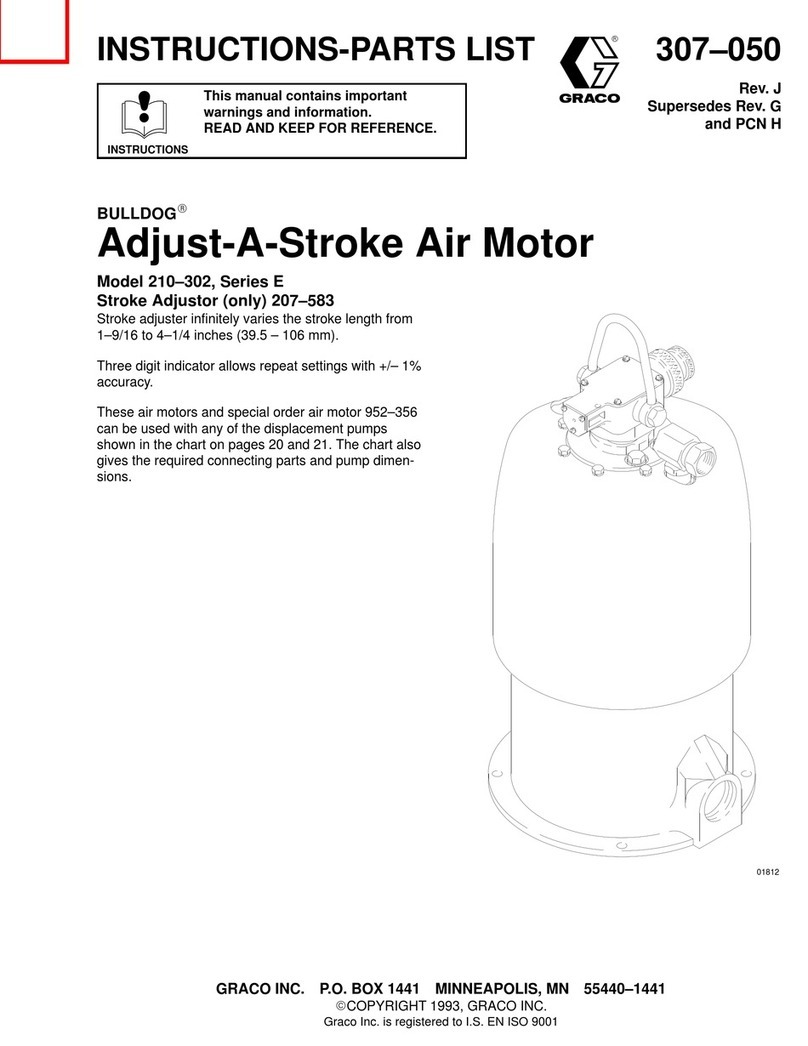
Graco
Graco BULLDOG E Series Instructions-parts list

Quectel
Quectel M10 Hardware description
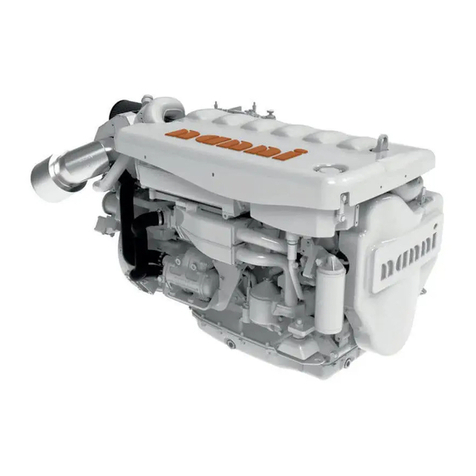
Nanni
Nanni N13.700 CR3 HD Operator's manual
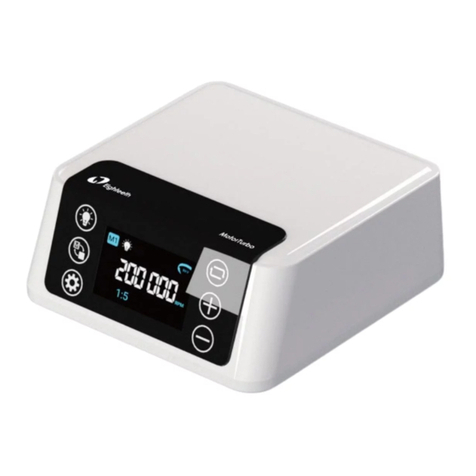
Eighteeth
Eighteeth MotorTurbo user manual
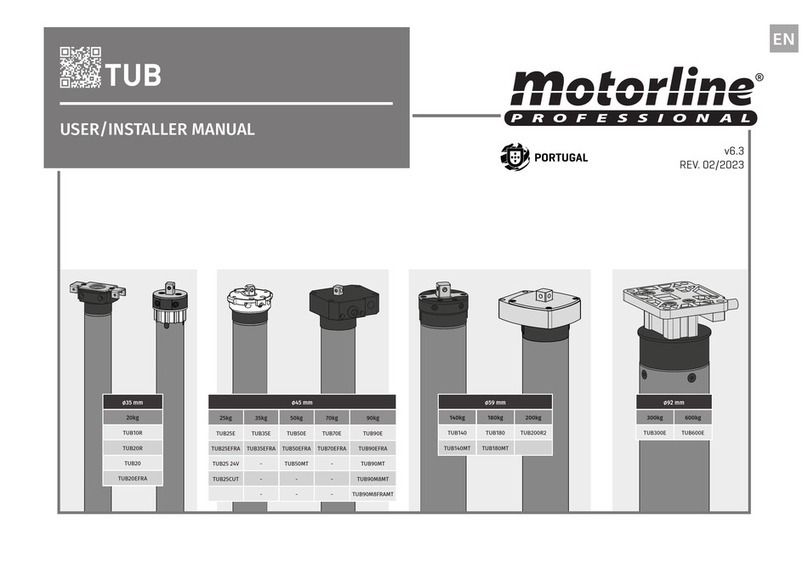
Motorline professional
Motorline professional TUB10R User& installer's manual
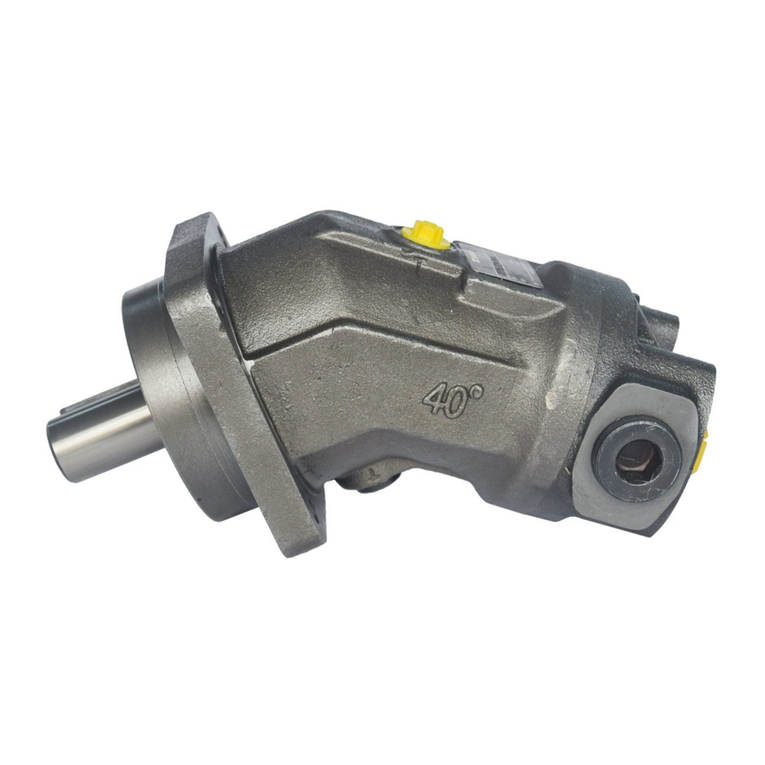
Mannesmann
Mannesmann Rexroth Brueninghaus Hydromatik A2F/6.1... Repair instructions
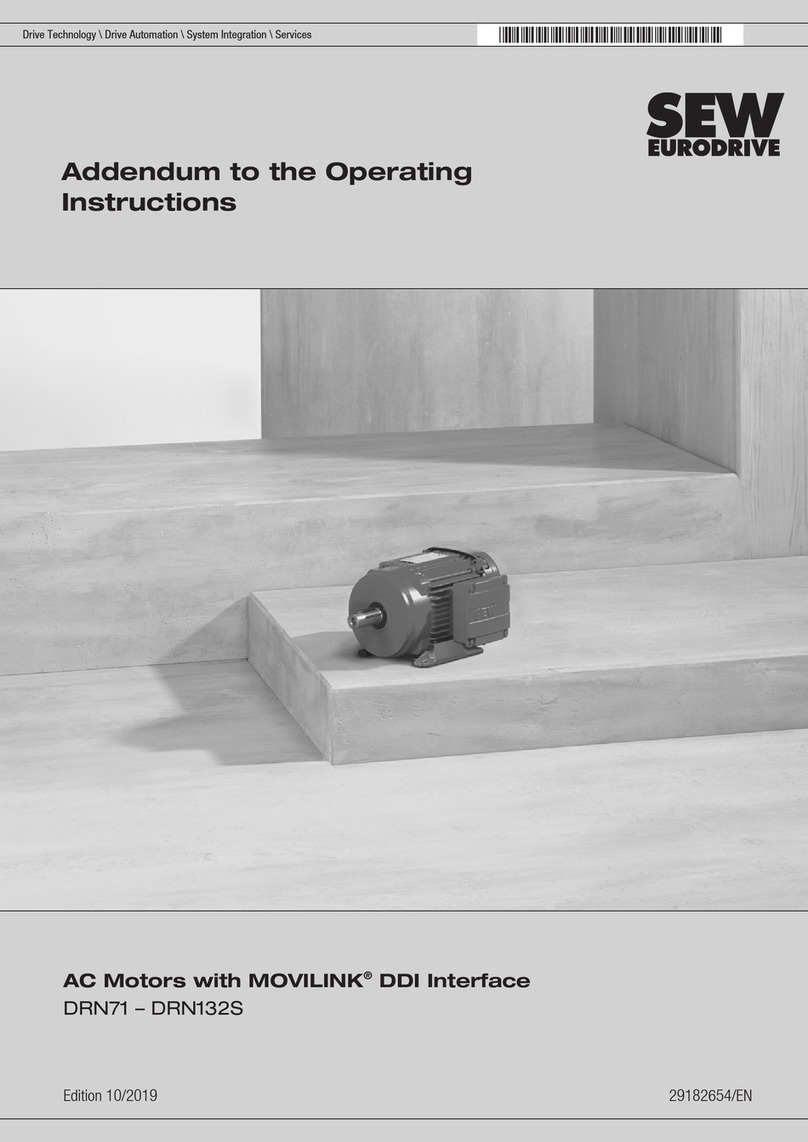
SEW-Eurodrive
SEW-Eurodrive DRN Series Addendum to the operating instructions
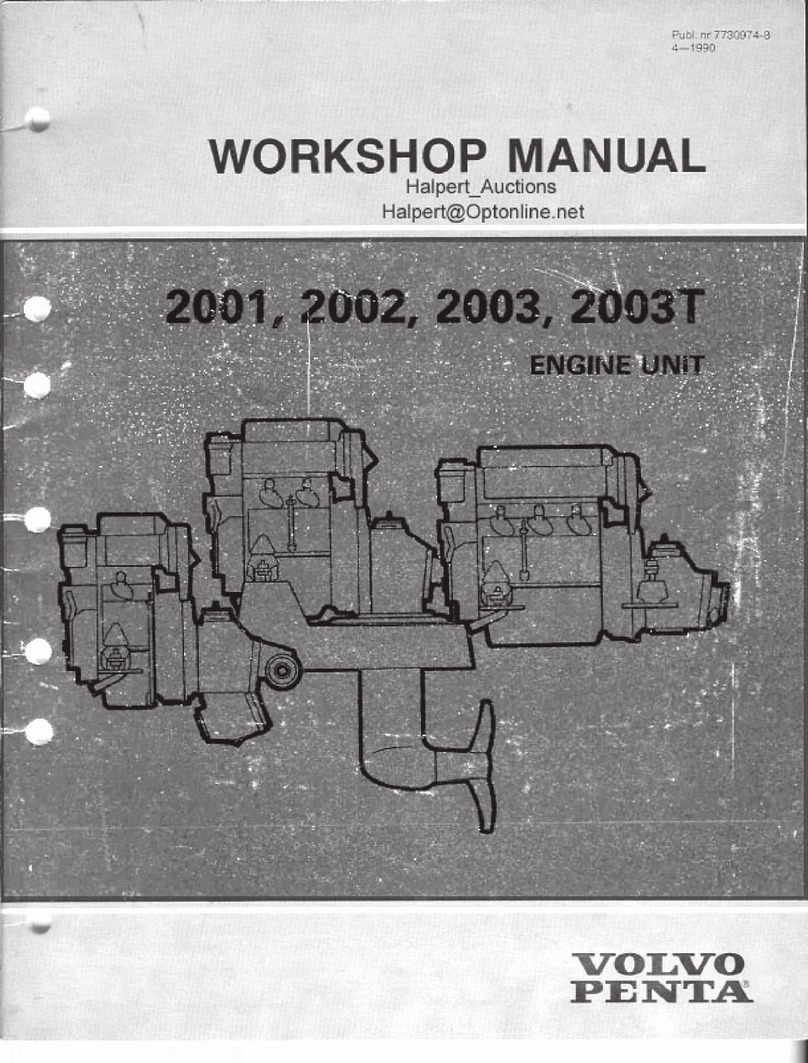
Volvo
Volvo 2001 Workout manual
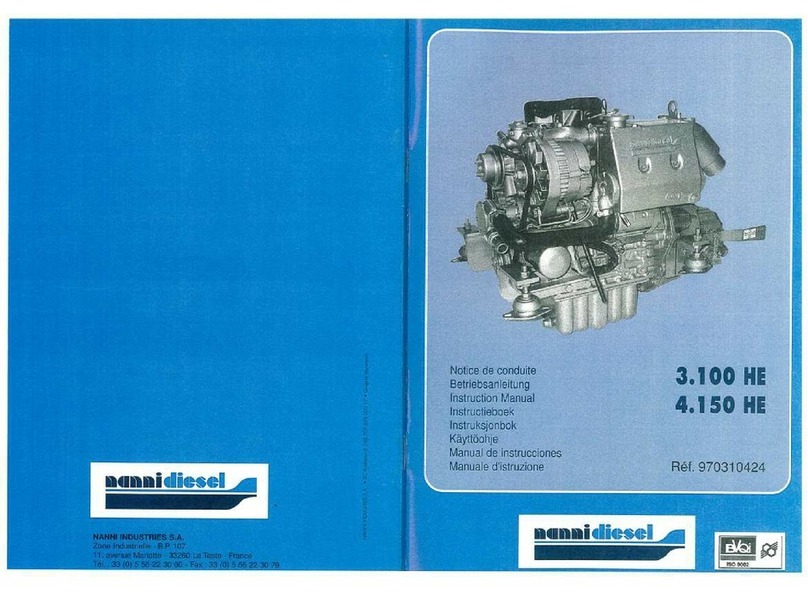
Nanni
Nanni 3.100 HE instruction manual
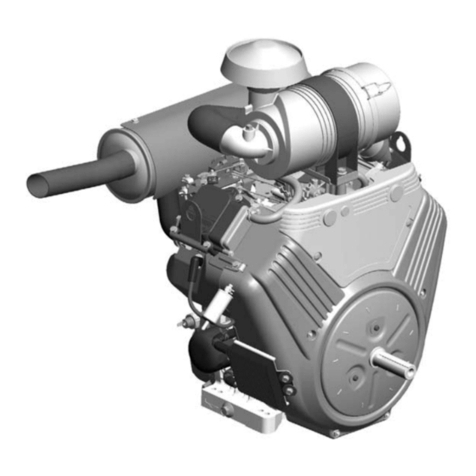
Briggs & Stratton
Briggs & Stratton Vanguard 610000 Operator's manual

Siemens
Siemens SIMOTICS S-1FK2 operating instructions
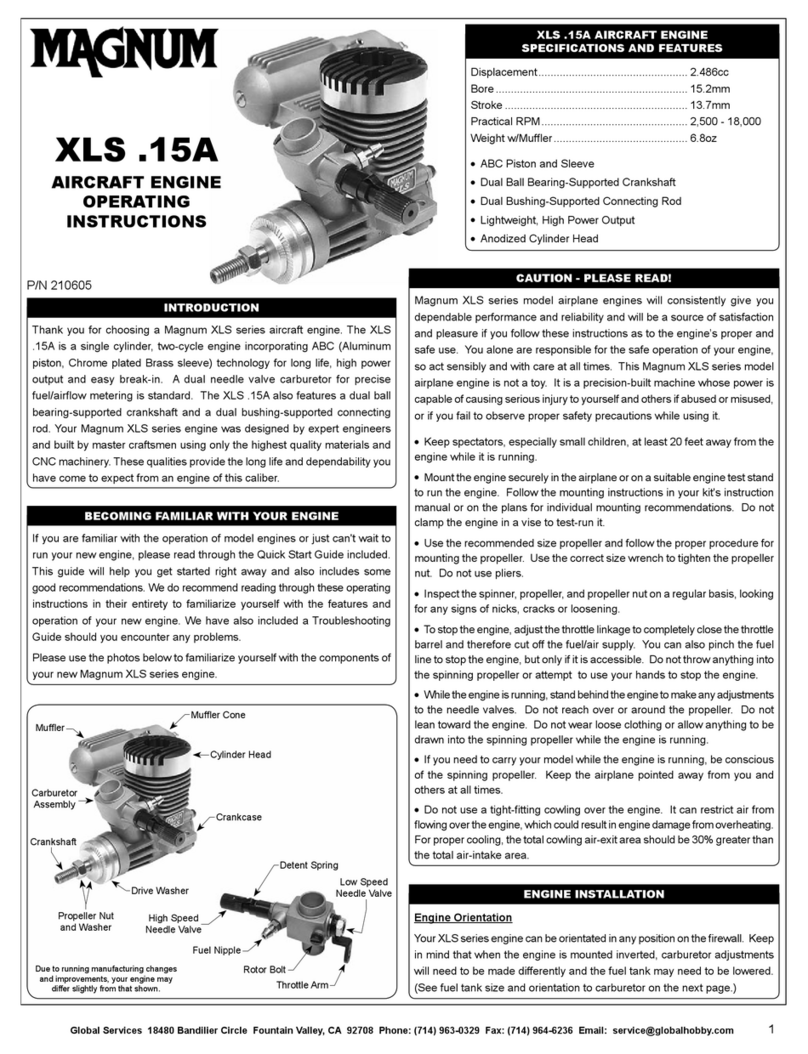
Magnum
Magnum XLS .15A operating instructions
